Five key questions remain
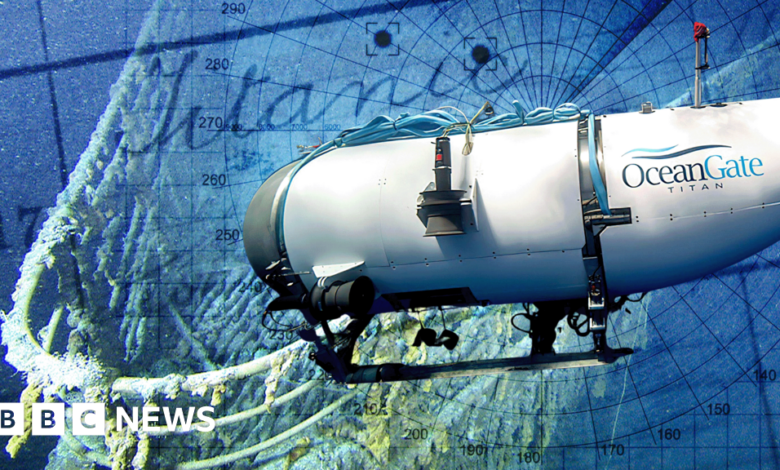
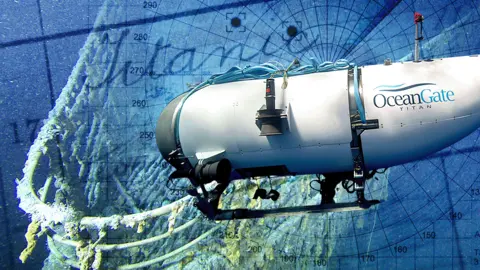 Titanic / Getty
Titanic / GettyIt is a submarine that promises passengers the trip of a lifetime. The opportunity to descend 3,800m (12,500ft) below the Atlantic Ocean to visit the wreck of the Titanic.
But last year, a dive by Oceangate’s Titan submarine went tragically awry. The vessel suffered a catastrophic failure as it neared the seabed, killing all five people on board.
The U.S. Coast Guard will hold a public hearing on September 16 to examine why the disaster happened, from the submarine’s unconventional design to overlooked safety warnings and a lack of regulation in deep waters.
Titan began sinking beneath the waves on the morning of June 18, 2023.
On board were Oceangate CEO Stockton Rush, British explorer Hamish Harding, veteran French diver Paul Henri Nargeolet, British-Pakistani businessman Shahzada Dawood and his 19-year-old son Suleman.
That same day, after the ship failed to surface, the United States Coast Guard was notified, initiating a large-scale search and rescue operation.
The world watched and waited for news of the missing submarine. But on June 22, the wreck was discovered about 500m (1,600ft) from the bow of the Titanic. The Titan had exploded after just one hour and 45 minutes of diving.
Here are five key questions that still need to be answered.
 Provided via Reuters/AFP
Provided via Reuters/AFPDid the passengers know the dive was going wrong?
Those on Titan can stay in touch with the support ship, the Polar Prince, via text messages sent over the ship’s intercom system. This exchange log could reveal whether there are any signs that the submarine is in trouble.
The ship also has acoustic monitoring equipment — essentially microphones mounted on the submarine to listen for signs of warping or breaking up.
“Stockton Rush believed that if a submarine was about to crash, they would get an audible warning on that system,” explains Victor Vescovo, a leading deep-sea explorer.
But he said he was very skeptical that this would provide enough time for the submarine to return to the surface. “The question is how quickly will that warning come?”
If there were no obvious problems during the landing and no alarms sounded, those on board may have been unaware of their impending fate.
The explosion happened instantly, the passengers didn’t even have time to realize what was happening.
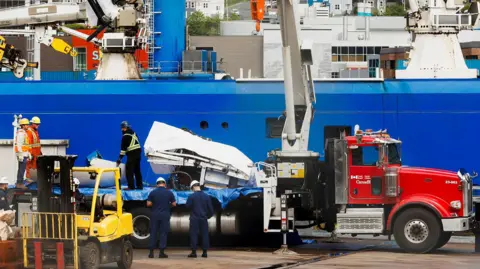 Reuters
ReutersWhich part of the Titan submarine was damaged?
Forensic experts have examined the wreckage of the Titan to determine the cause of the accident.
There are some design issues.
The viewing window is only rated by the manufacturer to a depth of 1,300m (4,300ft), but the Titan can dive nearly three times deeper.
The Titan’s hull also has an unusual shape – cylindrical, rather than spherical. Most deep-sea submarines have spherical hulls, so the impact of crushing pressure at depth is evenly distributed.
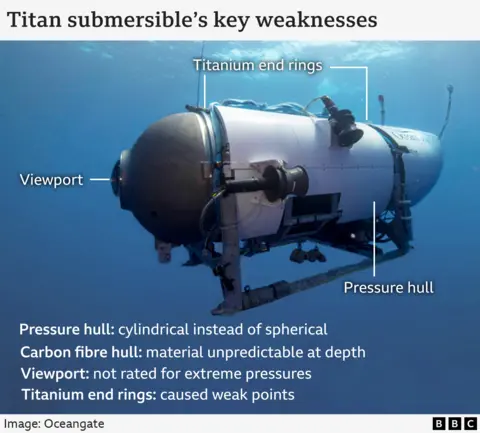
The submarine’s hull is also made of carbon fiber, an unusual material for deep-sea submarines.
Metals such as titanium are most commonly used because of their ability to withstand high pressures.
“Carbon fiber is considered an unpredictable material. [in the deep ocean]”, explains Patrick Lahey, CEO of Triton Submarines, a leading manufacturer.
Every time Titan went down to Titanic – and it did many dives – the carbon fiber was compressed and damaged.
“It gets weaker and weaker because the fibers break,” he said.
The joints between different materials are also a concern. The carbon fiber is bonded to two titanium rings, creating weak points.
The commercial ancillary industry has a long and unblemished safety history, says Patrick Lahey.
“The Oceangate machine is an anomaly,” he told BBC News.
 United States Environmental Protection Agency
United States Environmental Protection AgencyWill the noise from the ocean distract from the search?
Ships, aircraft and remotely operated vehicles (ROVs) have been dispatched to the Atlantic Ocean to try to find Titan.
Several days after the search began, underwater noises were reported picked up by search aircraft’s sonar, raising the possibility that the noises were coming from a submarine.
An ROV was sent to determine the source but found nothing.
It’s still unclear what those sounds were – ocean waves are loud and even louder during an activity like this.
A more relevant underwater sound was detected by the US Navy’s sonar system at the time of the submarine’s disappearance – an acoustic signal consistent with an explosion. The information was only made public the day Titan’s remains were found.
It is not known when the US Coast Guard was notified of the noise — or whether family and friends waiting on the submarine support ship were notified.
Eventually, deep-sea robots returned to where Titan went missing and found the wreck.
Rory Golden, who was on the Oceangate expedition when contact was lost, recently told the BBC that those on board the surface ship spent four days in fear and “false hope”.
Why did Oceangate ignore safety concerns?
Many people are concerned about the Oceangate submarine.
Victor Vescovo said he was so concerned that he advised some passengers not to dive on the Titan – including his friend Hamish Harding, one of the five who died.
“I told him firmly that he should not go into the submarine,” he said.
Safety concerns were also raised directly at Oceangate – including by the company’s former marine chief executive, David Lochridge, who assessed the submarine during development.
US court documents from 2018 found that Lochridge had identified numerous “serious safety concerns” and that the lack of testing could “put passengers at extreme risk in the experimental submarine”.
Engineers from the Marine Technology Association also said Oceangate’s testing method could lead to “negative consequences (ranging from minor to catastrophic)” in a letter shared with Stockton Rush.
In an email exchange was presented to BBC News last year.Deep-sea research expert Rob McCallum told Rush that the submarine should not be used for commercial deep-diving operations and would put passengers in a “dangerous situation”.
In response, Rush said he was “tired of people in the industry trying to use the safety argument to stop innovation” and dismissed warnings that he would kill someone as “baseless”.
With the Oceangate CEO dead, we will never know why he chose not to listen to these concerns. But public hearings could reveal who else at the company knew about them—and why nothing was done.
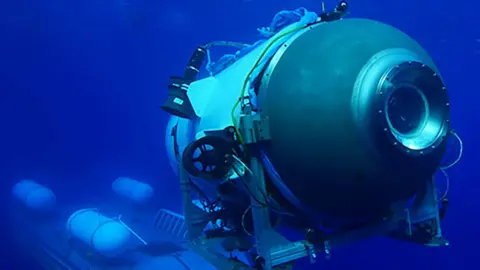 Ocean Gate
Ocean GateWhy did the government allow Titan to dive?
Deep-sea submarines may be subject to extensive safety assessments conducted by independent maritime industry organizations such as the US Bureau of Shipping (ABS) or DNV (a globally recognized organization headquartered in Norway).
Oceangate decided not to include Titan in the process.
The assessment will confirm whether the ship – from design to construction, testing and operation – meets certain standards.
Most operators opt for deep sea submarine certification – but this is not mandatory.
Rush describes his submarines as “experimental,” and in a 2019 blog post he argued that certification “slows down innovation.”
In an email exchange with Rob McCallum, he said he didn’t need a piece of paper to prove Titan was safe, and that his own protocols and passengers’ “informed consent” were enough.
Passengers on Titan paid up to $250,000 (£191,135) for a seat. They were all required to sign a liability waiver.
 Oisin Fanning
Oisin FanningIrish businessman Oisin Fanning made two dives to Titan in 2022 – the last before the submarine suffered a fatal disaster.
He said the Oceangate team took safety very seriously, with briefings before every landing. But he was not explicitly told that Titan was not yet certified.
“I would be lying if I said I didn’t think something similar had been done — that it was in compliance with certain standards,” he said.
“We all knew that Titan was a test vessel. We were very confident, because obviously we had done a few dives before, and it seemed to work well.”
The public hearing will last for two weeks. It is hoped that the answers it provides can prevent a disaster like this from happening again.





